Voting Information
General Voting Information
Who is elected
The following positions will be elected at the 2025 Election:
1 Mayor - elected by all voters
14 New Plymouth District Councillors
5 are called "District Wide" and elected by all voters
6 are elected from the Kaitake-Ngamotu General Ward* (Okato to Bell Block on the North side of New Plymouth)
1 is elected from the Kohanga Moa General Ward* (Egmont Village and Lepperton through Inglewood and covering some of Stratford)
1 is elected from the North General Ward* (Tikorangi through Urenui to the New Plymouth Northern Boundary and inland boundary).
1 is elected from the Maori Ward and elected by people enrolled on the Maori Roll.
* Explanations of the wards and where you live are shown in a section further down this page.
20 Community Board Members*
4 for the Clifton Community Board - From Tikorangi, through Urenui, Tongaporutu to the New Plymouth North Boundary, and covering some of inland Stratford.
4 for the Inglewood Community Board - Lepperton, Egmont Village, most of Inglewood through to Tarata.
4 for the Kaitake Community Board - Okato, Oakura, Omata and across to Egmont Village and Inglewood.
4 for the Puketapu-Bell Block Community Board
4 for the Waitara Community Board
*Explanations of the Community Board functions are shown in a section further down this page.
* Maps are included in a section further down of the boundaries for the different Wards and Boards.
11* Taranaki Regional Council Members - 8 will be voted for from the New Plymouth Region
5 for the New Plymouth General Constituency*
2 from the North Taranaki Constituency*
1 from the Taranaki Maori Constituency - voters on the Maori Roll
* The other 3 people to be voted for will be voted from South Taranaki and Stratford
* Constituency means a group of voters living in a specified area
Who isn’t elected- NPDC Staff and Committees
There are 2 groups of people involved with Council decisions who voters do not get to choose.
The Senior Management Team - The current team, and who reports to who, is in the next section on this page. The Senior Managers are paid employees of the NPDC. We don't vote for them.
For each 3 year term, a structure is decided for the types of Committees needed to make Council decisions. The Mayor is very influential in which Committees will be created. Some Councillors are appointed to these Committees.
If a Councillor is appointed to a committee, or leads one, they are paid a higher rate for the extra responsibility. We vote for these Councillors who are on these committees.
These committees can also have other people involved with them who we don't vote for. Some of these people are paid for their time, some are not. Some people are permanently on these committees, and some join for a short time for a particular issue. This varies across the different committees.
Below is the latest chart of the Committee Structure which has been used for the NPDC 2022 - 2025 Term.
You will see the 2 Lines at the top of the chart are who we vote for at the NPDC.
In the 6 boxes in the middle of this chart - the word Mayor - or the letters Cr - show us where the people we voted for are making decisions. You will also see who is leading (Chairing) these committees. Most of those Chairpersons we voted for - some we did not.
Where "Mayor or Cr" is not next to a name these are the people we did not vote for, who are making decisions alongside our elected officials.
In the bottom box there are other Committees and Working Parties. Some of these have Councillor involvement and some of these have people we did not vote for. Some non elected people are paid and some are not.
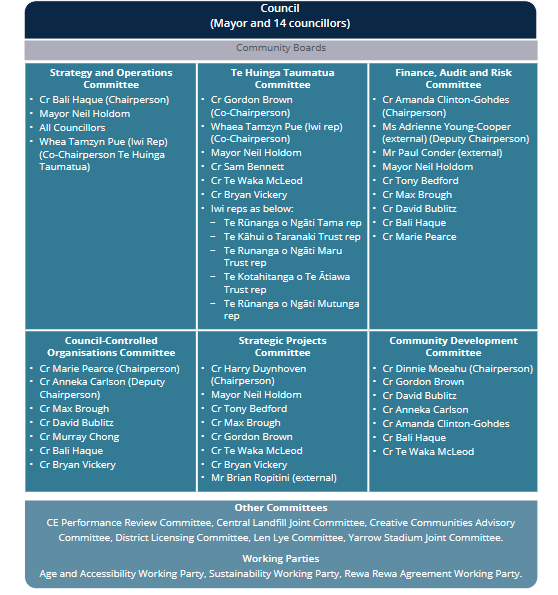
How much do people get paid for the paid positions on these committees ?
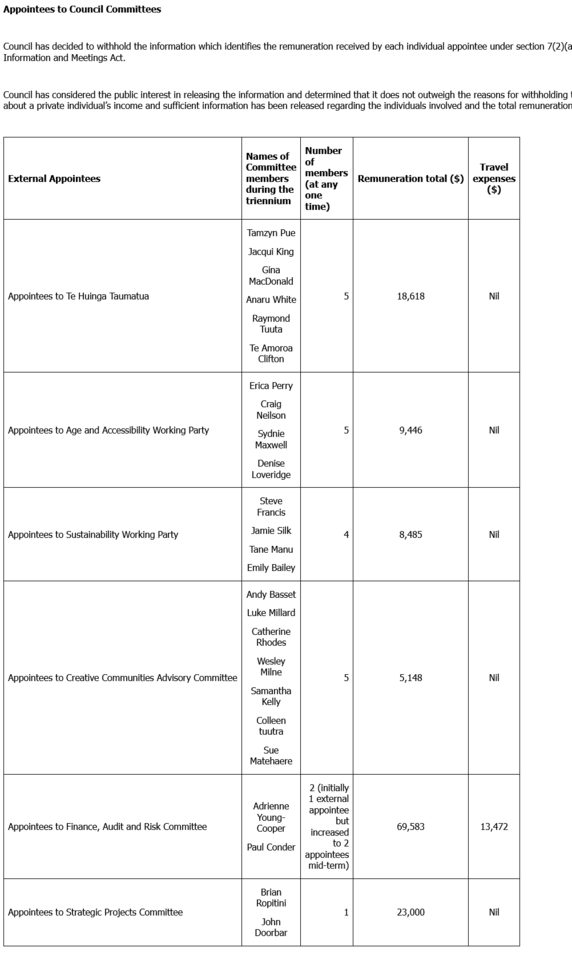
Who isn’t elected- Council Controlled Organisations (CCO's)
We do not elect the people who run Council Controlled Organisations (CCO's).
CCO’s are businesses the NPDC and Regional Council own on behalf of Ratepayers.
Council-controlled bodies are organisations which the Council’s have a 50 per cent or greater shareholding in, or level of governance control over.
CCO’s set their operational plans and provide these to the Councils. They must provide a Statement of Intent each year for Ratepayers to view, but Ratepayers have no say with what is in the actual plans.
If Ratepayers are not happy about the direction, they do not have a say to change that direction.
A board is appointed by the NPDC or Regional Council to oversee these CCO’s.
Ratepayers do not get to vote to elect the Board, or Management, of these CCO’s.
The CCO’s for NPDC are:
- New Plymouth PIF Guardians
- Forestry Joint Ventures
- Venture Taranaki
- New Plymouth Airport - Papa Rererangi i Puketapu Ltd (Prip)
The CCO’s for the Taranaki Regional Council are:
- Taranaki Stadium Trust (Yarrow)
- Regional Software Holdings
Port Taranaki – is not listed as a CCO - but is does have a Statement of Intent like a CCO.
(This statement is submitted by the Directors of Port Taranaki Limited (“Port Taranaki”, “Company” or “Port”) in accordance with the requirements of Section 9 of the Port Companies Act 1988. It sets out the Board’s intentions, objectives and expectations of the Company for the period 1 July 2025 to 30 June 2028.)
Who are the current NPDC Senior Managers
The Mayor appoints the NPDC CEO. The CEO reports directly to the Mayor.
The Council Senior Managers are appointed by the NPDC CEO and we don’t vote for any of these Council Employees.
In 2025, the Council Senior Management employees are:
- Chief Executive (CEO) - Gareth Green
- GM Corporate Innovation - Jacqueline Baker
- GM Operational Excellence - Sarah Downs
- GM Strategy and Planning - Helena Williams
- GM Te Tiriti Partnerships - Bernie O-Donnell
- Executive Director CE Office - Kathryn Scown
Attached is a chart of the employment arrangement:
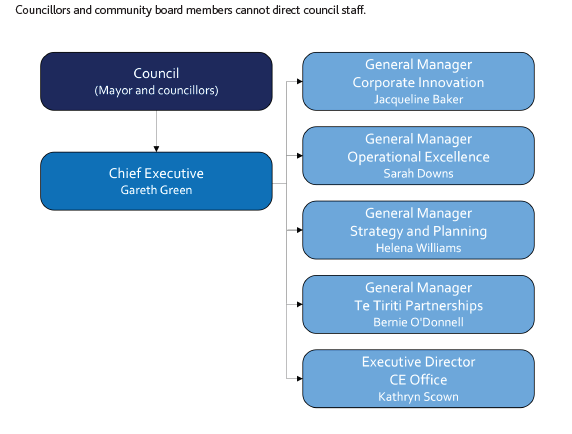
New Plymouth is divided into different Wards for voting. Where is your Ward area and who do you get to vote for ?
*There is a Map below showing the Ward Voting Areas to see who you can vote for.
Have a look at the map to see the name of the ward where you live, then have a look down this list to see how many people you can vote for.
All Voters will have the Candidates standing for the Mayor to vote for.
And, all voters will have the 5 "District Wide" candidates to vote for.
Then, the Kaitake-Ngamotu General Ward will have 6 other people to vote for
The Kohanga Moa General Ward will have 1 other Person to vote for
The North General Ward will have 1 other person to vote for
People voting on the Maori Roll will have 1 other person to vote for
Then, go to our "Meet the Candidates" page to see which people you can chose in your ward area.
All voters will also have the 4 Community Board members in their ward area to vote for - explained below.
And voters will have either 2 or 5 Regional Council Members to vote for - depending if you live in New Plymouth or North Taranaki.
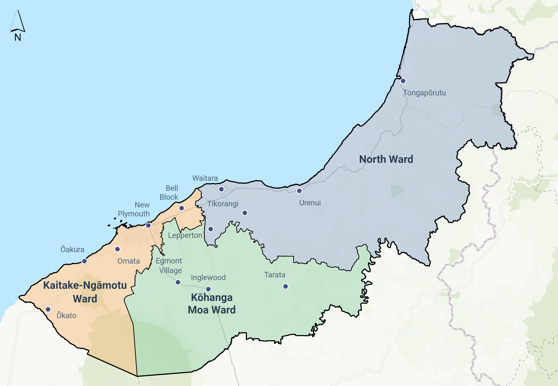
What do the officials on Community Boards do ? Where is your Community Board Area ?
*A Map is attached below for the Community Board Voting Areas to see who you can vote for.
Community boards in New Zealand were established and are governed by the Local Government Act 2002 and the Local Electoral Act 2001. These boards act as representatives and advocates for their communities, in our case, providing a local voice for communities outside of the New Plymouth City area.
New Plymouth District Council’s Community Boards are not committees of Council and they do not vote on decisions made by the Mayor and Councillors at Council Meetings.
There are 4 positions to be voted on for each Community Board. If 4 or less people stand for a Community Board, they will automatically be elected to Council. This year this has happened for 3 Community Boards:
Bell Block and Clifton have only 4 Candidates.
Kaitake has only 3 candidates. They are automatically elected, and one more person will need to be found in a by-election.
The New Plymouth Boards prepare an annual submission to the council regarding expenditure within their community. NPDC gives the Community Boards an annual budget – around $150,000 – which must be spent in the year it is allocated. The Community Board’s role is to communicate with the community on the best way to use these funds for the good of the community.
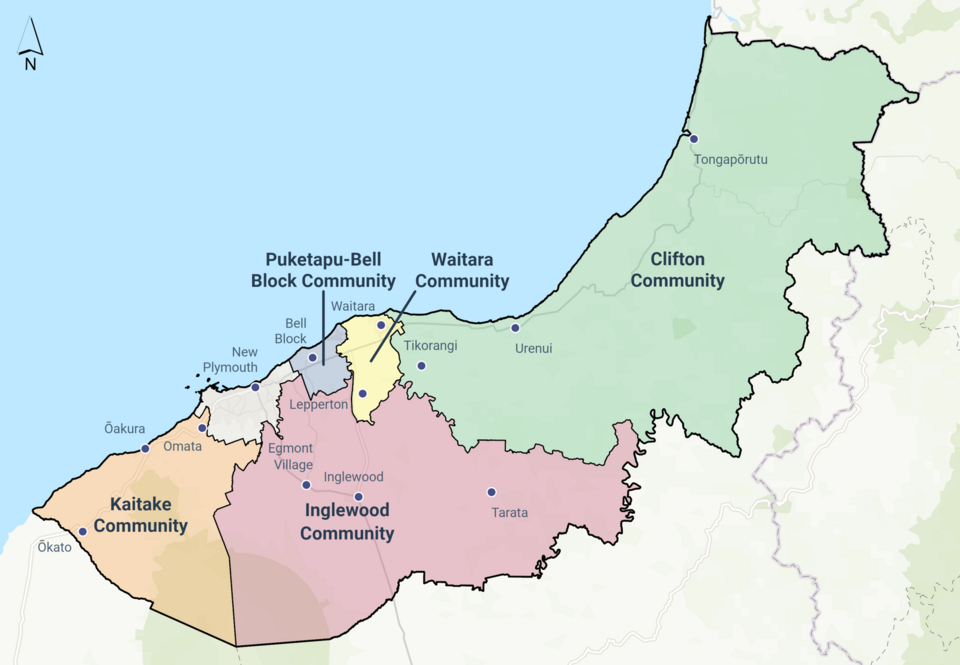
How to Vote with Single Transferable Voting (STV)- NPDC
STV Voting
The New Plymouth District Council uses the STV method for Voting.
This stands for Single Transferable Voting (STV).
This system was chosen by the NPDC to use at this time. The system itself can be reviewed, and changed, every six years.
STV is very complicated. The Alliance is not a huge fan of it because it is way too complicated for most people to understand.
We will try to break this down to help you with how to vote.
We have a short version, but to understand that better, read more of the detail of how STV Voting works.
The Short Version
The STV Voting system is very complicated
Practice on a piece of paper before filling in your voting form
DO NOT tick the boxes
Write a number - Rank people in the order you want 1, 2, 3 etc
You don't have to put a number next to every name
Only vote for someone if you want them to be a Mayor or Councillor
If you vote for people you don't want, your votes for them can be transferred to other people on your list - so only vote for who you want.
The Voting Quota
With the STV system a quota is used for the number of votes a Candidate must receive to be elected. (Quota is a fancy name for a number but it’s the term the government uses).
The Quota is worked out after the election closes. This number is worked out by how many positions there are to be filled and then by how many valid votes have been received. If more people turn up to vote the quota number will be higher, if less people turn up to vote the quota number will be lower.
In 2022 The quota for Mayor was over 12,500 votes, the quota for Councillors in the General Ward was around 2,300 and for the District Wide Ward was around 3,800.
To be successfully voted in at Liardet St you need at least a few thousand votes.
How you vote on your voting papers
You will have a list of names to choose from – based on where you live (See below how voting works with the Ward Area where you live).
We strongly recommend you rank your votes on a sheet of paper before you mark votes on your Voting Form – so you are really clear what order you are voting for people and you have a correct set of numbers.
DO NOT tick next to the names – or your vote will be invalid.
Use only a black or blue pen.
Don’t write anything else on the paper or it could be disqualified
Write a number next to the names you want to vote for. Rank them in the order of the person you most want to be in Council – and just vote for those people that you do want to be in Council.
For the person you most want to get into Council put 1
For the person you next want to get in put 2.
For the person you next want to get in put 3.
And so on.
You can vote for as many, or as few, people as you like.
It is important that you must have a valid series of numbers in a row. If you are missing a number in the order then votes after the mistake won’t be counted.
So if you voted for 5 people but had numbers
1, 2, 3, 5, 6
So you missed number 4 – all of the votes after number 3 will be ignored – because there is not a number 4.
This is where it starts to get tricky.
If you vote for someone who is very successful – so they reach the quota number for votes they need – any extra votes above that quota are transferred to your second choice candidate.
Or, if you vote for people who don’t get enough votes for the quota - so won't get voted in - then those votes will also be transferred to your second choice candidate among the rest of your choices of candidates.
This transfer of votes happens for every single voter.
Instead of ranking all the candidates by the total number of votes they received, this system uses a computer program to transfer your votes to your second, third, fourth, etc choice of candidate.
You can rank as many or as few candidates as you want to, depending on how many candidates you support.
You do not need to rank all the candidates on the list. For your vote to be counted you only need to write a single ‘1’.
You only need to rank the candidates you want to support. If you rank a candidate, that may help them to get elected. So don’t rank candidates if you don’t want them to get into Council.
By giving the number “1” to a candidate, you are saying that the candidate is your number one choice. By ranking candidates in your preferred order – 1, 2, 3, 4 and so on – you are also saying which other candidates you prefer, and will be happy for them to get in.
If your top choice doesn’t have enough support to get in or, if your top choice doesn’t need all the votes they received to be elected, then your vote for all the other candidates you ranked will be transferred to those candidates.
An example of how the votes transfer to your second, third etc choice is here from the Department of Internal Affairs:
https://www.stv.govt.nz/how.shtml
So what do we do – how do we get the people we want in to Council
- Vote for the people you really want who are on your voting form.
- Do not vote for the people you don’t want – or they may get enough transferred votes to get them in.
- If you don’t put a number next to a candidate their vote can’t be transferred to another person. (It becomes a non transferable vote)
- We need a majority of 8 people, across all the wards, sitting around the council table who won’t vote for continual spending and debt.
- Keep an eye out for our events (and watch for our videos of these) and check our track record of existing Councillors, our candidate profiles and candidate answers to our questionnaire – to see which candidates may keep down spending and debt.
- Try to find people to vote for in your ward who can say NO to the trend of saying yes to spending and debt. If all the different wards pick only the candidates who can say NO to spending and debt, we should be able to find a majority of 8 candidates across all the wards.
What to do once you’ve filled in your form:
Put your voting paper in the return envelope. Put it in the post – it DOES NOT need a stamp.
Or you can drop it in an official voting box (usually at libraries or council offices).
Voting closes at 12 noon on Election Day – Saturday 11th October.
Make sure it is in the post before the 11th or that you have dropped your form off before that date.
How to Vote with First Past The Post (FPP)- Taranaki Regional Council
First Past The Post Voting (FPP) – Taranaki Regional Council
In FPP voting you tick the name(s) of the candidates you most prefer.
You use a tick for each person and your tick is your vote.
When the votes are counted the candidates(s) with the most ticks (votes) are elected.
If there is one vacancy you can vote for one candidate.
If there is more than one vacancy, there is more than one tick.
